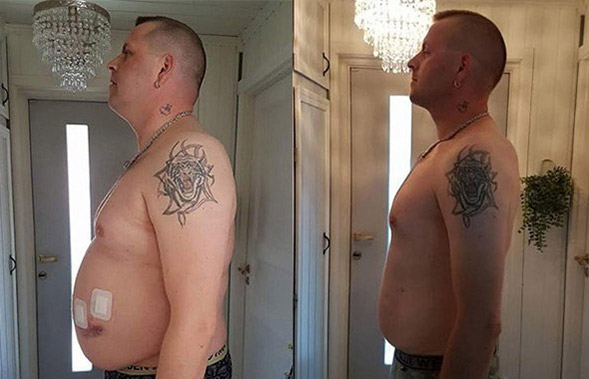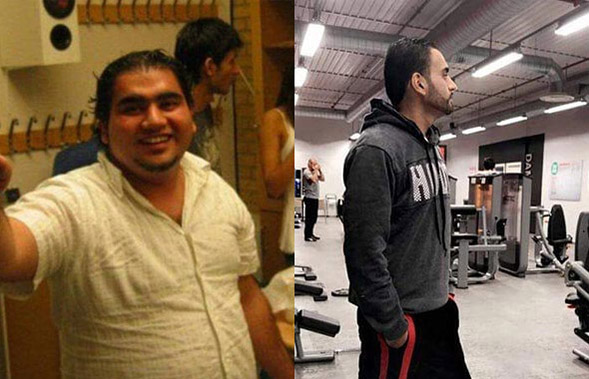Book Free Consultation
| Gastric Balloon | BMI 27+ |
| Gastric Sleeve | BMI 30+ |
| Gastric Bypass | BMI 35+ |
Choose the procedure that suits you best
Weight: Kg | Height: cm |
10 Reasons to choose us
BMI Range
Enter your body profile details to calculate the result.
Table of contents [hide]
- What is Mini-Gastric Bypass
- Origins of the Mini Gastric Bypass Procedure
- Jejunoileal Bypass
- Gastric Bypass
- Mini Gastric Bypass
- The Procedure
- Benefits
- Risks
- Short term risks in the immediate aftermath of surgery (up to 7 days)
- Longer term risks
- Pain
- Complications
- Recovery
- Cost of Mini Gastric Bypass Surgery
- More About the Overvekts Operasjoner Riga Clinic
- More About Riga
- Am I a Good Candidate?
- Exactly How Much Weight Will I Lose?
- FAQs
What is Mini-Gastric Bypass
Mini gastric bypass surgery has been gaining favour recently due to its relative simplicity and affordability. It’s typically marketed as a simple, minimally invasive, laparoscopic weight loss surgery and it is all of those things to be sure. Below we’re going to take a comprehensive look at exactly what is the mini gastric bypass, its origins, its benefits and hazards. We’ll also go into the benefits of having this type of surgery performed abroad and cover some FAQs as well.
Origins of the Mini Gastric Bypass Procedure
In order to better understand what the mini gastric bypass procedure is it is helpful to know what it evolved from. The “mini” bypass is a form of bariatric (weight loss) surgery which was first performed in the 1950s. Bariatric surgery is practically unique in the annals of medicine because with one procedure a person can be potentially be cured of a slew of maladies. That’s because obese individuals typically suffer a host of weight-related health problems from diabetes to heart disease to respiratory conditions to hip and knee degeneration and more.
When these individuals undergo successful bariatric surgery they will typically find that their hip and knee problems are suddenly reduced to very manageable levels that may not require replacement, that their blood sugar becomes stabilized at normal levels, that any respiratory difficulties are relieved and pulmonary function is often restored through exercise and that the strain on their heart is removed. As such bariatric surgery deserves a special place in the pantheon of surgical procedures.
Mini-Gastric Bypass Surgery Package 58 900,-NOK
What’s included in the package – read here.
Jejunoileal Bypass
The jejunoileal bypass (JIB) was one of the first types of bariatric surgery. It left the stomach intact but bypassed most of the intestines in order to foster a state of malabsorption. While it produced good weight loss results it was eventually discontinued because it lead to a slew of complications from diarrhoea to osteoporosis to kidney stones, night blindness and more. Bacteria often grew unchecked in the bypassed intestine and caused a rash of other problems including arthritis and liver failure.
Gastric Bypass
This form of bariatric surgery was first developed in the 1960s as an alternative to JIB surgery. Surgeons had observed how patients who had had part of their stomach removed due to ulcers would often wind up losing significant amounts of weight. Through trial and error the gastric bypass technique was perfected using the Roux-en Y intestinal limb. RNY surgery, as it’s commonly called today, is now the most common form of bariatric surgery. With RNY surgery a small pouch is created from the stomach where it meets the oesophagus. The small intestine is divided into two segments with the upper segment being bypassed and the lower attached directly the new tiny stomach. The rest of the stomach is also bypassed.
Mini Gastric Bypass
The mini bypass is a variation on – some would call it a refinement of – the standard RNY gastric bypass surgery. The name “mini” often confuses people and its origins are yet a bit unclear. Some believe it refers to the new “mini stomach”. Others are convinced it refers to the fact that there is less manipulation required of the small intestine. While still others believe it refers to the fact that the surgery itself is less invasive and so “mini” by comparison to the more labour intensive RNY bypass.
Whatever the exact meaning of the name this procedure was developed 20 years ago and was at first slow to catch on, with only 4,000 of the procedures being performed in the first 10 years of its existence. Most people were at first unwilling to weigh the mini gastric bypass surgery pros and cons and instead simply opted for the proven commodity, the RNY, and that is certainly understandable. Slowly however, the walls of resistance wore down as word spread of its low impact effectiveness and affordability. One event that helped shine a spotlight on the procedure occurred in 2005 in when actor Gil Gerard (Buck Rogers) underwent the procedure as part of a Discovery Channel TV show. The program followed his progress throughout the months after surgery, during which time he lost an amazing 140 pounds. After this TV show the mini gastric cat was out of the surgical bag.
The Procedure
The mini gastric bypass procedure stands up well in the gastric bypass vs mini gastric bypass debate because it is a faster, easier, less complex method of achieving the benefits of a standard gastric bypass. In most cases the surgery will take about an hour and be far less physically impactful that other types of weight loss surgery. Typically there are 5 steps involved in the process of creating the mini gastric bypass and they are:
- Gaining access – A set of 5 incisions each only 1 inch long are made in the abdominal wall. These will allow the insertion of the camera and light along with the necessary surgical instruments. Different access ‘ports’ (as they are referred to) will be used at different points during the operation.
- Liver retraction – In its natural position the liver lies over part of the stomach. In order to avoid damage to this vital organ it is gently lifted out of the way; in effect set aside so that the procedure can continue.
- Dividing of the stomach – The stomach is then divided into 2 parts: one large and one small. The large portion will no longer be used while the small section will serve as the patient’s new stomach going forward. This small pouch is already attached directly to the oesophagus so there is no manipulation required at that end. For the record the part of the stomach that is cut away remains “alive”. It is simply no longer used.
- The bypass – Exactly how much of the small intestine is bypassed will vary depending on the patient. Typically it’s anywhere from 3 to 6 feet. The location where the intestine is to be connected to the new stomach is moved into position at the bottom of the new small stomach pouch and surgically joined. Unlike in an RNY bypass the small intestine is never sliced all the way through but rather the new stomach is joined to the side.
- Verification and closure – Once the bypass is complete the surgeon double checks their work looking for anything that seems off. When they are convinced all is as it should be the various surgical instruments as well as the camera are removed and the incisions closed.
Your new bypass will work its magic in 3 primary ways:
- Just as with an RNY procedure the new tiny stomach created during the gastric bypass will restrict how much you can eat.
- Because a portion of the small intestine is bypassed fewer calories will be absorbed thus setting the stage for even greater weight loss.
- By reducing the size of the stomach levels of the hormone ghrelin which generates feelings of hunger are reduced. As a result you won’t be tempted to eat as much or as often.

Benefits
The mini bypass procedure will provide a wealth of benefits including:
- Reduction in co-morbidities – These are conditions that an individual would not otherwise experience and which are tied directly to their obesity. Examples include diabetes, oedema, respiratory problems and more.
- Potential for a longer life – Research has shown that obesity can shorten the life of an individual by 6 and 8 years compared to people of average weight.
- Improved outlook – Numerous studies have demonstrated that obese individuals suffering from a variety of depressive conditions typically experience a marked improvement in their outlook and attitude toward life after losing significant amounts of weight.
- Lower risk of complications – Because the procedure is performed through tiny incisions there is less chance of infection and other complications.
- Shorter recovery period – The fact that there is less cutting and repositioning of the small intestine with this type of bypass surgery means that recovery times are usually shorter than with more involved procedures.
Risks
When it comes to mini gastric bypass vs gastric sleeve there is little doubt the mini bypass is less invasive and internally disruptive. It is still, however, a form of major surgery and as such there are risks and potential complications involved. Below we’re going to go through the litany of those risks and potential complications beginning in the immediate aftermath of surgery and moving outward into the long term recovery period.
Short term risks in the immediate aftermath of surgery (up to 7 days)
- Nausea and vomiting
- Diarrhoea
- Bleeding from the incisions
None of these are considered serious and even the bleeding incisions should resolve themselves in a few days. More serious potential complications include:
- Leaking or abscess
- Infection either internal or at the site of the incisions
- Blood clots in the lower legs
- Pulmonary embolism
If you show any signs of these complications you should contact your doctor immediately.
Longer term risks
- Abdominal wall hernia
- Osteoporosis/bone loss
- Malnutrition
- Insufficient weight loss
- Peripheral neuropathy
- Vitamin deficiency
Most of these complications are extremely rare and can be prevented by being studious in following the postoperative advice of your surgeon and dietitian.
Pain
For the most part pain and complications from this type of bariatric surgery are nearly the same as those associated with traditional RNY gastric bypass.
While there will be some pain and discomfort in the days immediately following the procedure it’s typically nothing that can’t be effectively managed with pain medications. In most cases you will be particularly aware of pain and discomfort in the first two weeks if you twist your torso for any reason. But again, you should be able to handle any pain and discomfort using standard pain medications. As you move beyond the 2 week mark pain will subside and you will be weaned off pain medications.
Another thing to keep in mind is that you are going to be fatigued as you begin to lose weight rapidly after surgery. This is to be expected and is nothing to panic about. You will need to endure this phenomenon and rest assured, it will pass as your body adjusts to the new reality. Regular exercise (nothing too strenuous of course) is the best antidote. You’ll be advised to get up and move around starting on your first day home and by the 1 week mark you should be taking fairly long walks (20 to 30 minutes) twice a day. Don’t do anything more strenuous without consulting your doctor.
Complications
There are some potentially serious complications associated with bariatric surgery although it must be emphasized the odds of these occurring are slim. Still, you need to know what you are getting into.
- Narrowing of the connection between the small intestine and the reconfigured stomach.
- Bile reflux gastritis. A condition wherein bile flows back into the stomach from the small intestine.
- Dumping syndrome wherein food moves too quickly from the stomach to the intestine causing nausea, dizziness and/or diarrhoea.
- Leaks along the staple line.
- Scar tissue.
- Gallstones.
- Fistulas.
Potential minor complications include the chance of hernias at the site of the surgery and infections in and around the incisions as noted above.
Recovery
- Immediately following surgery – Following mini gastric surgery in Riga you can expect to spend from 2 to 5 days recuperating in hospital. In Norway you will often be shown the door after 1 day so they could free up the bed for the next person in line. At Overvekts Operasjoner Riga however you will have the luxury of spending enough time in our care so that when the time does come to go home you will be entirely ready to do so. And you won’t have to worry about a few extra days draining your bank account either.
- The first 2 weeks – As we mentioned earlier during the first couple of weeks you will likely experience some pain and discomfort but it should be easily handled. You will not be allowed to leave the hospital if you still require IV pain medications, although this almost never happens. Once home your diet after mini gastric bypass will consist of liquids for the first 2 weeks. While it’s possible your doctor may allow you some pureed foods in less than 2 weeks it is not likely. So plan on 14 days. During this time you will stay in close contact with your patient coordinator and should be sure to report any issues. You will be advised to take certain supplements to avoid potential problems related to malabsorption and your medical team will be able to suggest ones that won’t cause problems with your new stomach.
- 2 to 8 weeks out – After 2 weeks on your liquid diet you’ll begin to introduce semi-solid foods into your diet. This will include pureed foods along with things like plain yogurt and Jello. After a further 2 weeks (4 weeks after surgery) on a combination of soft foods and liquids you will finally be able to reintroduce solid foods into your diet. But that doesn’t mean it’s time for a trip to the pizza shop. Instead you’ll take baby steps eating things like well cooked vegetables, soup and fruit. By the end of week 8 you should be eating mostly solid foods and also have established some healthy eating habits.
Cost of Mini Gastric Bypass Surgery
As we mentioned at the beginning of this guide mini gastric bypass surgery is touted for its affordability but affordability is a relative term. What is affordable to some is out of reach of others. The fact is if you really want to save money on this type of procedure without sacrificing quality you’ll need to consider having your mini bypass abroad. The chart below should spell out in stark relief just how wide the disparity is in costs between having your bypass performed in Oslo and having it perform at Overvekts Operasjoner Riga in the Latvian capital.
The above prices represent an average of prices from various locations within each city listed. Nonetheless they demonstrate just how much more mini gastric bypass cost in Norwegian clinics when compared to Latvia. Even a renowned hub of medical tourism such as Bangkok will cost you some 20% more on average than Riga plus you’ll need to spend several times as much on airfare and won’t realistically be able to return there should you need to should complications arise.
Riga has become a preferred destination for those seeking affordable weight loss surgery in Europe because of its newly expanded and upgraded airport, its virtually unmatched digital infrastructure, it’s state of the art medical facilities like the Overvekts Operasjoner Riga clinic, the highly educated and experienced world class surgeons and medical support staff and, of course, the fact that you’ll save a boatload of money over mini gastric bypass surgery cost in the UK without sacrificing quality.
More About the Overvekts Operasjoner Riga Clinic
- Modelled after the most advanced clinics in Western Europe.
- Flat screen TV and free WiFi in every patient room.
- Free accommodation for family member in every room.
- Leave Oslo after breakfast have lunch in Riga.
- Personalized, round the clock care from our highly trained staff.
- Full rehab facilities on site.
The cost of mini gastric bypass surgery in Norway will be twice that of Latvia and in Oslo you’ll be pushed out after a day to make room for someone else. Why endure all that when you can enjoy the brand new, spacious, high-tech accommodations of the Overvekts Operasjoner Riga clinic? At Overvekts Operasjoner Riga all your needs will be catered to by our bilingual staff and you’ll be able to fully recuperate before going home.
More About Riga
Weight Loss Riga would not hold the same attraction to patients if it were located somewhere else. With a history that stretches back more than 8 centuries Riga has played an important part in the European story. It has experienced the march of history first hand and was an important commercial and cultural crossroad as early as the 13th century. Germans, Poles, Swedes, Russians and more have come this way and left their mark and yet there is no mistaking the fiercely independent nature and distinct cultural identity of the Latvian people.
When you choose to have your surgery at Overvekts Operasjoner Riga you’ll come for the world class medical care and you’ll come back for the people and the place.
Am I a Good Candidate?
Before scheduling your surgery with Overvekts Operasjoner Riga you will need to fill out our health and wellness questionnaire. You can get it by calling our Patient Coordinator in Norway or by filling out the enquiry form on our website. Once you have completed the form and returned it to us it will be thoroughly reviewed by our medical staff to determine whether you meet the criteria for this type of surgery. Rest assured that unless you have some significant mitigating condition the chances of you being accepted are good. However, it is vital that you fill out the questionnaire as fully as possible so that our medical team can make an informed decision that will be in the best interest of your health long term.
If your application has passed muster with our medical team you will be invited to contact our Patient Coordinator and set up a date for your procedure. After you arrive in Riga you will undergo a preoperative examination and assessment the day before surgery to ensure you are physically capable of withstanding the stresses that accompany surgery. Should everything meet with the approval of the medical staff you will be put on a preoperative liquid diet in order to prepare your body for the procedure.
Exactly How Much Weight Will I Lose?
The amount of weight a patient loses will vary from person to person and depend on a number of factors, including:
- Your weight prior to the procedure.
- Your ideal weight as determined by the BMI (Body Mass Index).
- Your ability to adhere to the dietary and exercise recommendations of the medical staff.
If you are rigorous in your adherence to the postoperative diet plan and exercise in accordance with the recommendations laid out by the medical staff there is an excellent chance you will lose 70-80% of your excess weight and in some cases even more. While you will certainly lose a lot of weight even if you ignore your doctor’s advice, it will not be as much as it could be and you will open yourself up to complications. In short the amount of weight you lose will largely be up to you.
FAQs
How long will I be in surgery? – The procedure itself typically takes about 1-1.5 hours.
How long will I be in hospital? – If you have your procedure in Oslo you’ll pay twice what you would in Riga and be sent home 1 day after surgery. If you have your surgery in Riga you will save more than 50% on the cost and be able to recuperate for 2 full day, more if your medical team determine you need it.
How long will I be out of work? – While some people attempt to return to work a week after surgery we try to discourage this. No good can come from trying to hurry things after surgery. Unless you are able to telecommute from your home for a few hours a day we would recommend waiting at least 2 weeks before returning to work.
When can I start driving again? – In most cases we advise patients wait at least a week before attempting to drive. This allows adequate time for the various incisions and other surgical points to heal properly. Also, you may be taking painkillers for the first week or so and should definitely not drive if that is the case.
When should I start exercising? – The wisest course of action is to return to physical activity in a slow, measured way. Start by taking short, easy walks the first few days and take it from there.
Will I be hungry all the time? – No. One of the many benefits of this surgery is that it results in a reduction of the hormone ghrelin, which influences appetite. Less ghrelin, fewer hunger pangs.
Will I be left with a lot of scars? – The laparoscopic nature of this surgery will leave only a few small scars, each an inch or so in length. In time they should fade and be barely visible.
Can I eat fast food after surgery? – One of the most important aspects of the post-surgical period is building sound eating habits. If you were a bit of a junk food aficionado before surgery it will be important that you leave that aspect of your life behind you. The emphasis will be on eating healthy food, low in fat and sugar, so that the weight loss you experience can be sustained for a lifetime.
Will I go bald? – No. It is however, not uncommon for patients to experience thinning hair while they go through their dramatic weight loss in the year following the mini gastric bypass procedure. This is because your body is undergoing enormous changes and everything from vitamin to hormone levels are naturally going to be affected. In almost all cases however once the bulk of the weight loss has occurred and the patient’s physical situation has stabilized any lost hair will grow back. So there is no need for concern.
Do I have to follow the recommendations of my dietitian? – Only if you want to enjoy a successful outcome. It must be remembered that permanent weight loss and a healthier you is a two part process. The first part is the actual surgery that, no matter what, will result in significant weight loss. The other part is making the necessary diet and lifestyle changes so that you enjoy optimal weight loss and that you are able to sustain it over the long haul. Surgery without your cooperation afterward will only yield middling results.
Can I have other cosmetic surgery immediately following this procedure? – Some patients want to celebrate their newfound healthy profile by scheduling surgery as soon as possible to remove excess skin and other things. We however, recommend you wait at least 1 full year before scheduling any additional surgical procedures to give yourself the best opportunity to meet your ultimate weight loss goal and to give your body time to adjust and to the new reality.
Is there such a thing as unsuccessful mini gastric bypass results? – In the vast majority of cases this type of surgery is completely successful. That is, the patient meets their weight loss goals and is able to sustain their healthy new profile. In the tiny portion of instances where this is not the case it is almost always a matter of the patient being unable to comply with the diet and exercise recommendations of the medical staff after surgery. As such it is not a surgical failure but a follow up failure.
Can Mini-Gastric Bypass help me lose weight?
Mini-Gastric Bypass is a simple and minimally invasive weight loss surgery that reduces the used space of the stomach. This procedure promotes weight loss, because the person will eat less, fewer calories will be absorbed and the feeling of hunger reduced. However, the long-term results and how much weight exactly one can lose largely depend on the patient’s willingness to change eating and exercising habits.
What are the requirements for undergoing Mini-Gastric Bypass?
All potential patients of Mini-Gastric Bypass must fill out the health and wellness questionnaire that can be received by calling to our patient coordinator in Norway or enquired on our web site. Medical team will review each questionnaire and decide whether the surgery is in the best interest of the patient. Before the surgery, patient’s readiness for the procedure will be examined once again.
How much do I have to pay for Mini-Gastric Bypass?
In Latvia the price for Mini-Gastric Bypass is Kr 58 900, while the same treatment in Norway costs Kr 120 000. The surgery package covers accommodation, all essential fees and procedures and 5-year follow up. Learn more about the costs and everything included in the package from the price list.
Why should I have Mini-Gastric Bybass done abroad and not in Norway?
If you want to save money without sacrificing quality you should consider having the Mini-Gastric Bypass surgery abroad. The same procedure costs more than twice as much in Norway as it does in Latvia. Other arguments for having the surgery abroad include highly experienced, trained and equipped medical staff, easy travelling between Norway and Latvia, and a surgeon’s liability insurance that insures extra patient safety.
What are the competences of the surgeons and medical staff?
All of the medical services provided by Overvekts Operasjoner Riga, including Mini-Gastric Bypass, follow the highest European standards. The clinic’s leading bariatric surgeon has an experience of 25 years in general surgery and more than 10 years in bariatric surgery. Visit our “Clinic & Surgeons” page for more information on the medical credentials and qualifications of our staff.
How likely will I be able to keep extra weight off after Mini-Gastric Bypass?
Mini-Gastric Bypass surgery is a faster, less complex and invasive method of achieving the benefits of a standard gastric bypass. Due to the reduced stomach size, patients will eat less, feel less hunger and absorb less calories. That said, the success of maintaining the new weight depends on the patient’s ability to comply with the diet and exercise recommendations given by medical staff.
Can one undergo Mini-Gastric Bypass for a second time?
The second set of Mini-Gastric Bypass may be appropriate in order to redo or repair the results of the previous treatment. However, the surgery isn’t normally redone if post-surgery weight gain is caused by the patient’s lifestyle. To avoid this situation, patients should start developing healthy eating and exercising habits immediately after the first procedure.
How can I get further information on Mini-Gastric Bypass?
For more in-depth information on Mini-Gastric Bypass surgery or Overvekts Operasjoner Riga clinic, please contact our patient coordinator Mona Karlsson by writing to mona@overvekts-operasjoner.no or calling 451 145 93. You can also get in touch with us online, by using the contact form on our web page – add your contact information and questions and we will reply you as quickly as possible!
Conclusion
Mini gastric bypass surgery has exploded in popularity in recent years as people have become aware of its many advantages relative to other types of weight loss surgery. There’s no doubt that mini gastric bypass results speak for themselves, but you’ll still want to discuss the matter with your physician and our Norway Patient Coordinator on 451 145 93 or through the enquiry form on the website before deciding whether or not this type of procedure is for you.


























 I am a 26 year old girl from Trondheim. Throughout my life, I’ve struggled with extra weight/being obese. It’s something that has affected me both physically and psychologically.
I am a 26 year old girl from Trondheim. Throughout my life, I’ve struggled with extra weight/being obese. It’s something that has affected me both physically and psychologically. 





